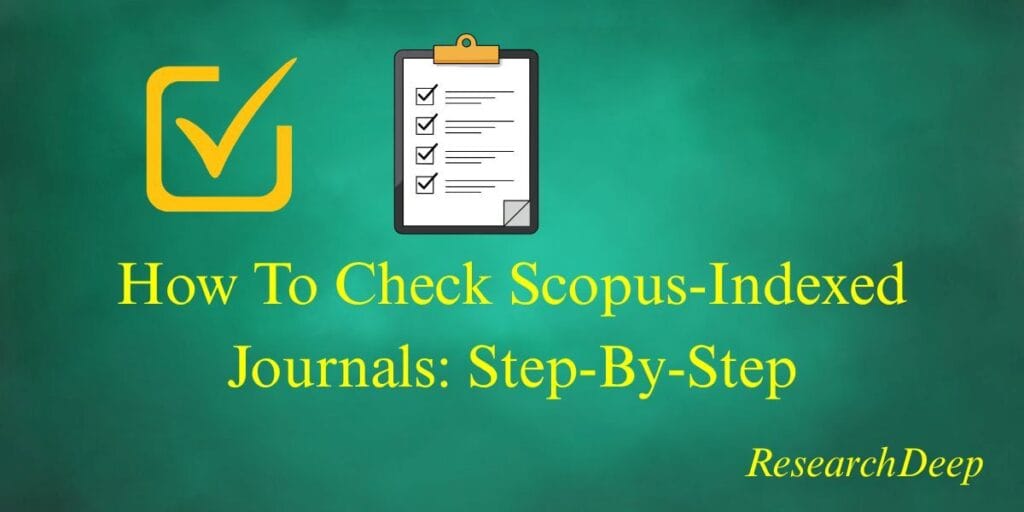Last updated on November 12th, 2025 at 03:23 am
Knowing how to check Scopus indexed journals is essential for scholarly publishing, PhD submissions, research evaluation, and avoiding predatory journals.
Scopus, maintained by Elsevier, is one of the world’s largest citation databases—covering more than 27,000 peer-reviewed journals across disciplines (Elsevier, 2024).
Because many low-quality or predatory journals falsely advertise Scopus indexing, researchers must independently verify a journal’s Scopus status before submitting manuscripts or citing it for academic purposes.
This article demonstrates two primary methods—and freely accessible—ways to confirm Scopus indexing:
✅ Scopus Sources Tool (Official and updated monthly)
✅ SCImago Journal Rank (SJR) portal (Built on Scopus data, shows quartiles)
Table of Contents
✅ Why It Is Important to Check If a Journal Is Scopus-Indexed
Verifying Scopus indexing is not just a formality—it directly affects academic credibility and evaluation. Journals indexed in Scopus:
✅ Demonstrates adherence to peer-review and publication ethics.
✅ Are vetted for quality, citation impact, publishing regularity, and transparency.
✅ Carry greater academic weight for PhD submissions, promotions, recruitment, and grant applications.
✅ They are internationally searchable and citable, improving visibility and research impact.
In many countries, including India, UGC, NAAC, and academic institutions often require researchers to publish in Scopus or UGC-CARE journals for their work to be recognized. Submitting to a non-indexed or falsely claimed outlet can result in paper rejection, academic penalties, or invalidation of research credit.
✅ Methods To Check Scopus-Indexed Journals
✅ Method 1: Using the Official Scopus Sources Tool (Most Reliable)
The Scopus Sources tool is the official database used to check if a journal is listed in Scopus. It is free and does not require a subscription for verification.
How To Check Scopus-Indexed Journals (Official Tool)
- Go to scopus.com/sources
- Search by Title, ISSN, Publisher, or Subject Area
- Tap Find Sources
- If the journal appears → It’s Scopus-indexed
- Open the journal profile and confirm Coverage years show “to Present”
- Watch for “coverage discontinued in Scopus”
✅ What “Coverage Years” Mean
- 2015 – Present or to Present → Actively indexed.
- Coverage discontinued in Scopus → Previously indexed, not active anymore.
- Coverage until 2018 → Not valid for Scopus-required publications today.
Publishing in discontinued journals will not count for official academic requirements.
✅ Method 2: Using the SCImago Journal Rank (SJR) Portal
SJR uses Scopus data and provides additional quality indicators, such as quartile rankings (Q1–Q4), the H-Index, and subject categories.
Check Scopus Indexing Using SJR
- Visit scimagojr.com
- Search by Journal Title or ISSN
- Open the profile page
- Check SJR score and Q1–Q4 quartile
- Note: SJR updates annually; Scopus Sources updates monthly
✅ If a journal appears in SJR, it is indexed in Scopus.
❌ But remember: SJR updates annually, while Scopus updates monthly.
✅ Red Flags: Signs a Journal Is Not Truly Scopus-Indexed
Many predatory journals falsely advertise Scopus indexing. Be cautious if you notice:
🚩 The Journal claims Scopus indexing only on its website, but it does not appear in Scopus Sources
🚩 No ISSN listed, or ISSN is invalid
🚩 Fake “impact factors”, such as:
- Global Impact Factor.
- Universal Impact Factor.
- Google Scholar Impact Factor.
(These are not legitimate metrics)
🚩 Journal was once indexed but shows:
- Coverage discontinued in Scopus
- Coverage until 2016, 2017, or 2018
🚩 Rapid publication promises (24–72 hours) with guaranteed acceptance.
🚩 Publisher has multiple questionable journals with identical layouts and suspicious fees.
🚩 The Journal’s editorial board lacks verifiable scholars or uses fake names.
🚩 Indexing logos appear in low resolution or link to irrelevant pages.
If any of these appear, always verify them in Scopus and SJR.
✅ Comparison Table: Scopus vs Web of Science vs UGC-CARE
| Feature | Scopus | Web of Science (Core Collection) | UGC-CARE (India) |
|---|---|---|---|
| Owner | Elsevier | Clarivate Analytics | UGC CARE Consortium |
| Coverage | Largest coverage; updated monthly | Highly selective; JIF-based | Screens for predatory journals; regional focus |
| Quality Indicators | CiteScore, SNIP & SJR quartiles | Impact Factor (JIF), JCI | Inclusion status only |
| How to verify | Use Scopus Sources | Use Master Journal List | Check UGC-CARE Group I & II |
Related Reads
Top Practices For Publishing In Academic Journals
What Is A Peer-Reviewed Journal?
16 Reasons To Publish In A Peer-Reviewed Journal
Key Takeaways: How To Verify Scopus Indexing
- Always verify journals on the official Scopus Sources page, not on publisher websites.
- Check coverage years; only “to Present” means active indexing.
- SJR confirms Scopus indexing and gives quartiles (Q1–Q4) for quality comparison.
- Beware of rapid acceptance claims, fake metrics, and discontinued status.
- For academic submissions, save a screenshot/PDF of the Journal’s Scopus page as proof.
FAQs: How to Check Scopus indexed Journals
How do I know if a journal is Scopus-indexed?
Search the Journal in Scopus Sources using Title or ISSN. If it appears with valid coverage years, it is indexed.
Can a journal be removed from Scopus?
Yes. If a journal fails quality standards, Scopus may discontinue coverage. Always check for “coverage discontinued.”
Is SJR the same as Scopus?
No. Scopus is the indexing database; SJR is a ranking tool built on Scopus data.
What is Q1 vs Q4?
Q1 = top 25% in discipline.
Q4 = lowest quartile
All are Scopus-indexed, but Q1 and Q2 usually indicate stronger journals.
Conclusion
Checking whether a journal is Scopus-indexed is critical for academic credibility, research impact, and official recognition. The most trustworthy verification method is the Scopus Sources tool, which is updated monthly and provides complete coverage records. The SCImago Journal Rank (SJR) portal adds valuable insight by showing quartile levels and impact indicators.
Because thousands of predatory journals falsely claim indexing, researchers should never rely solely on journal websites, email solicitations, or paid indexing claims. Verifying coverage years, checking for discontinued status, confirming ISSN details, and reviewing editorial transparency are necessary steps before submitting any manuscript.
By consistently following these verification methods, researchers protect their academic integrity, avoid predatory traps, and ensure their work receives proper visibility, citation value, and institutional acceptance.
References
- Elsevier. (2024). Scopus Source List. https://www.scopus.com/sources
- SCImago Research Group. (2024). SCImago Journal Rank. https://www.scimagojr.com
- Scopus Content Coverage Guide. Elsevier, 2024.
- Singh, V., & Xia, J. (2021). Scholarly journal indexing and research visibility. Journal of Information Science, 47(5), 622-635.
- DOAJ – Directory of Open Access Journals. https://doaj.org
- COPE – Committee on Publication Ethics. https://publicationethics.org



